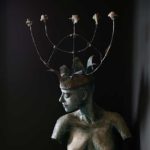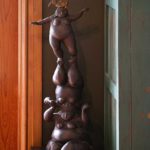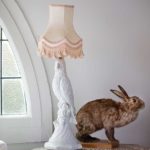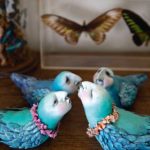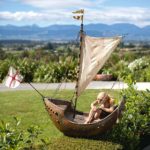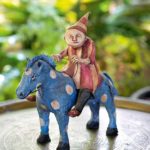WOW: At home with Suzie Moncrieff the creator of WearableArt
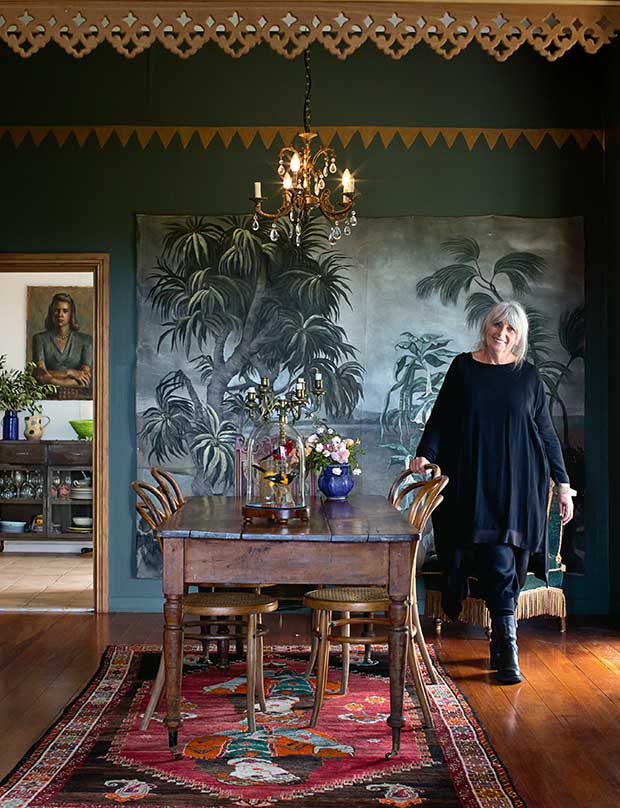
The dining table often becomes the scriptwriter’s base where, through the doorway, is an oil by portraitist Bessie Christie, active in the 1930s. Suzie bought the painting for $5 from an antique store, and is glad she didn’t know what it was worth at the time as she may have been tempted to sell it when money was tight. The botanical mural is by Kerrie Hughes, a fashion designer turned artist. The taxidermied birds in the belljars are from Richmond Antiques & Curios.
Vision, grit and a good shot of gumption propelled the World of WearableArt from a small-town show to a global spectacle. No wonder its founder’s Ruby Bay home reflects a life-less-ordinary.
Words: Emma Rawson Photos: Tessa Chrisp
This article was first published in the May/June 2018 issue of NZ Life & Leisure.
Dame Suzie Moncrieff couldn’t just have a normal everyday sheep. Instead of a standard fluffy white romney, she has Edith, a gotland that thinks it’s a horse and is infatuated with Reggie the ageing gelding. Cue Edith and Reggie galloping around the hills of Suzie’s Ruby Bay lifestyle block in a Benny Hill-esque chase; Reggie is charging at the neighbour’s flock with Edith, in a sort of sheepy canter, trying her darndest to keep up.
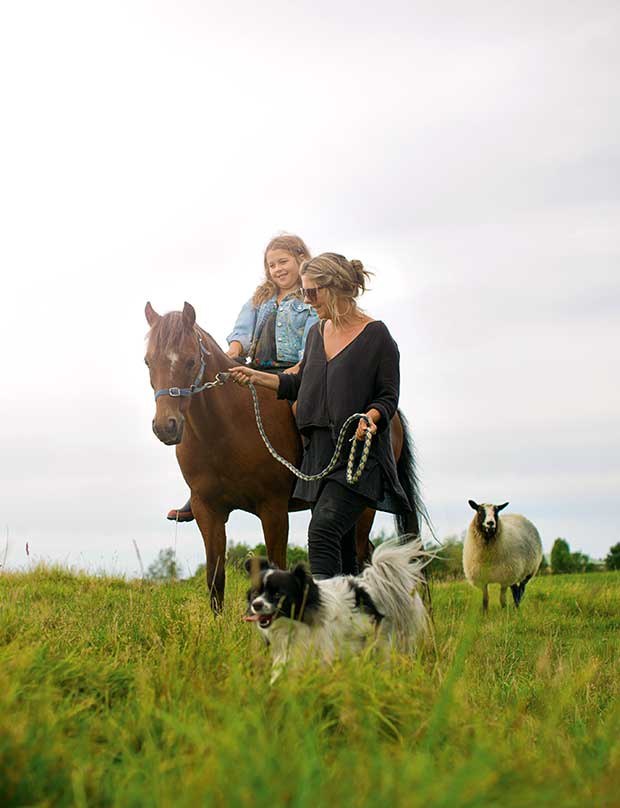
Reggie is getting on in years but still loves to be ridden by Daisy or to gallop through the hills with Edith the sheep in tow.
Suzie, in her billowing thespian blacks, watches on, bemused. Her daughter Emma and granddaughter Daisy (a great horse rider and actress – sometimes in combination) and farm-loving papillons, Margaret and Sammie, join her and now it’s a real party.
READ MORE: Be in to win a double pass to WOW and a Ruth Pretty WOW picnic hamper
The animals, with their human names, could be forgiven for assuming airs and graces, however Suzie, who has the formal title ‘Dame Suzie’, doesn’t stand on ceremony and quickly puts her guests at ease (she was made a Dame of the Order of New Zealand in 2011 for her services to the arts, for which she had previously been honoured in 1998).
While she has respect for the honour, she is a country girl, raised in the rural village of Hope, and isn’t one to just sit quietly and drink cups of tea staring at her view of the hills of Nelson and Nelson Lakes.
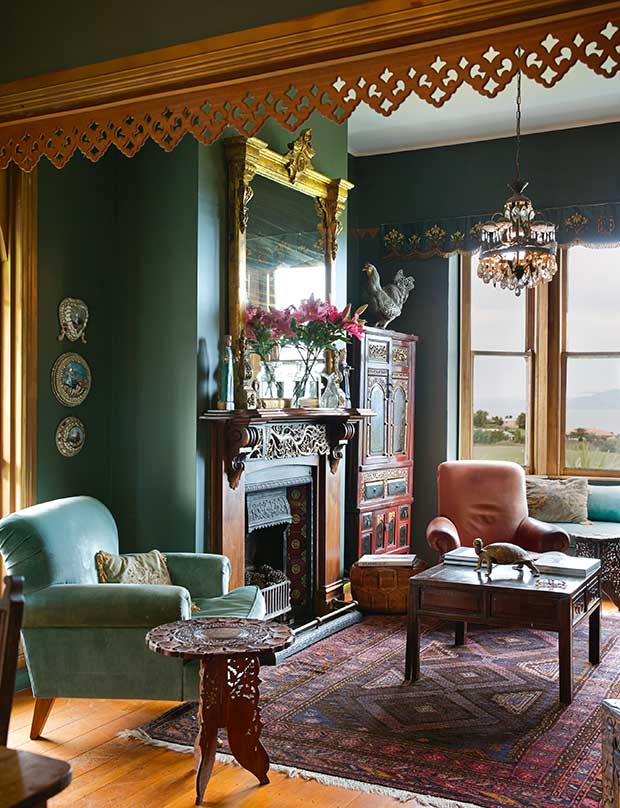
In the sitting room of Dame Suzie Moncrieff’s home with its view of the Nelson hills is a taxidermy turtle and rooster, once stars of WOW productions.
Her house, where the phone rings and rings and rings, is the creative epicentre of the World of WearableArt (WOW), the artistic competition and multimillion-dollar stage spectacular now held in Wellington, that is celebrating its 30th year.
The highly choreographed theatrical show features art pieces worn on the human body and attracts 60,000 viewers each year over a three-week season.
It’s been a long time since Suzie founded the show in 1987 in the William Higgins gallery, a historical cob cottage outside of Wakefield. These days the extravaganza is renowned in the global art scene and attracts weird and wonderful works of wearable art: last year there were registrations from designers from more than 40 countries.
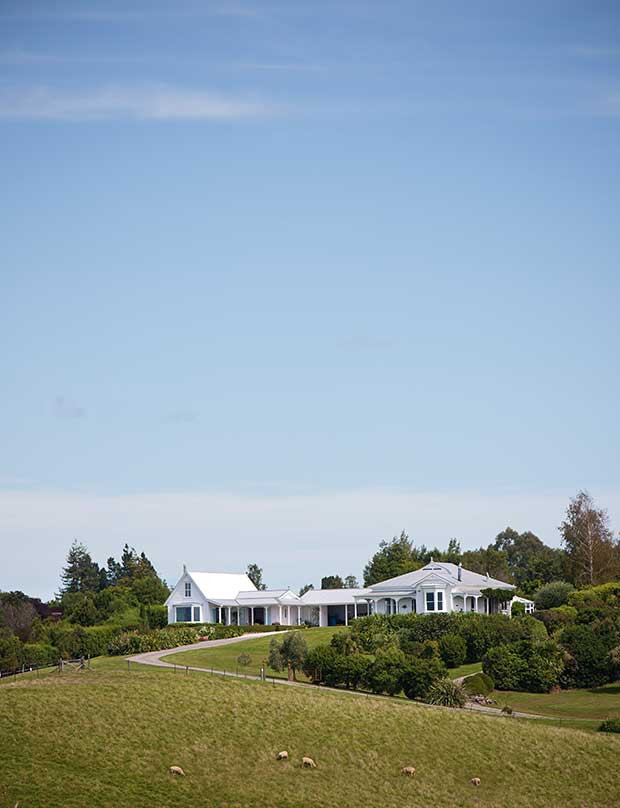
The Ruby Bay property is a former apple orchard, and Suzie’s house is joined to her daughter Emma’s by a garage. Suzie bought the neighbouring land to save it from developers. She has one sheep and a horse, but the neighbour’s flock grazes her land.
The planning and storyboarding of the show’s creative (with its cast of hundreds), usually starts at Suzie’s dining room table.
Suzie bought the Ruby Bay block in the early 1990s when the newly established New Zealand WearableArt Awards were still in Nelson. She had enough money (she and Emma were on a tight budget living on a restricted income) to buy the bare land of a former apple orchard.
“Where are you going to live?” asked her brothers, farmers in Wakefield. “I don’t know, in a tent or a caravan maybe.”
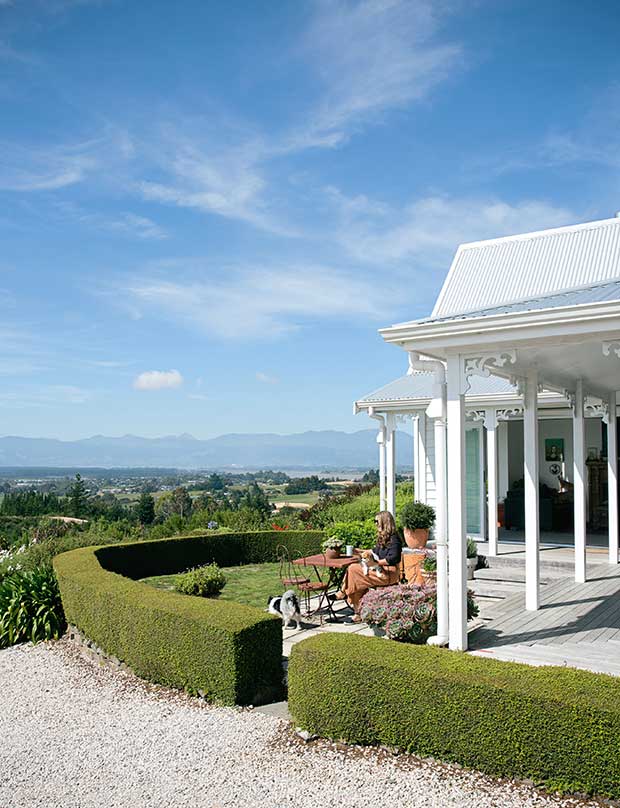
From the verandah, Suzie’s family’s farm can be seen on the hills in the distance.
Suzie called a house-removal company and they found her a 1910s house which, as luck would have it, was a childhood favourite that her family had often admired when driving past.
The house, cut into three and popped on the back of the truck, was inched through the winding hills to the property. The join mark where it was fused is still visible in the hallway floor under the chequered pattern painted by Suzie and Emma.
“Someone pointed out to me the pattern is not straight, but I don’t really care.”
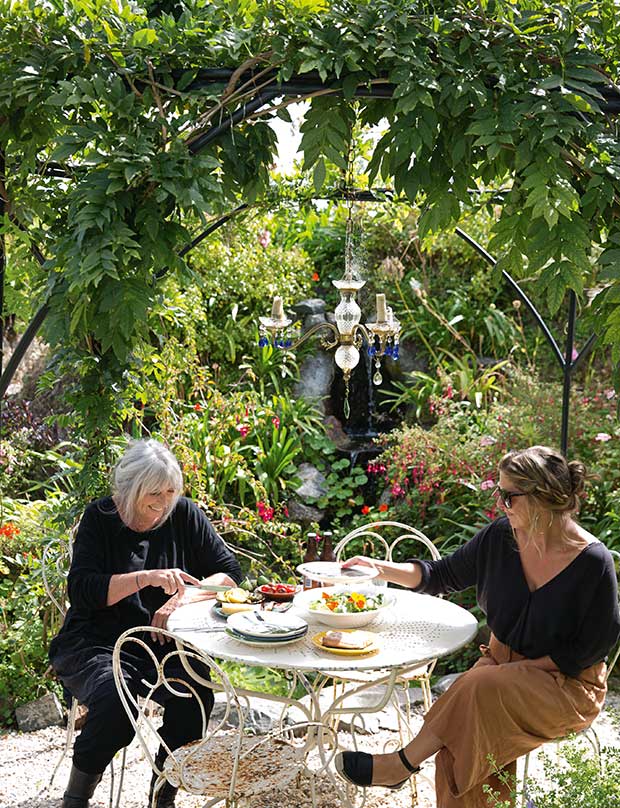
Emma’s sheltered garden, filled with flowers, is a great spot for lunch and for granddaughter Daisy to play in.
Although it was a tumbledown do-up, it did not faze this arty mother-and-daughter duo.
Both dab hands with the hot glue gun, they became equally as effective with tubes of No More Cracks. Fortunately Suzie had always had a thing about doors.
For many years she had pack-ratted away windows and “doors to nowhere” which she rescued from churches and derelict villas. It so happened she had the perfect amount stashed in her shed for replacing the out-of-place 1960s ones.
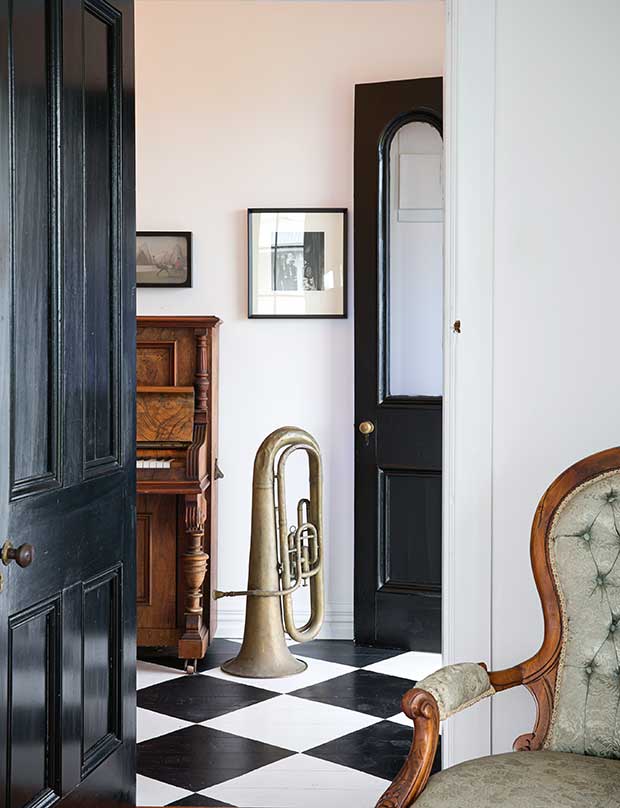
Suzie inherited the piano from her aunt and the tuba came in a brass-instrument shipment from France and was bought from Richmond Antiques & Curios. Music is a big part of Suzie’s life – she and Emma worked together on the score for past WOW shows.
She’s also resilient to the negative powers of doors: even when a door slams in her face, there’s usually a trail of glitter left behind.
Fundraising for the show was difficult at the beginning. One year, clutching her sparkle-encrusted portfolio and looking for prize money and venue fees, she met with the Nelson mayor in his office.
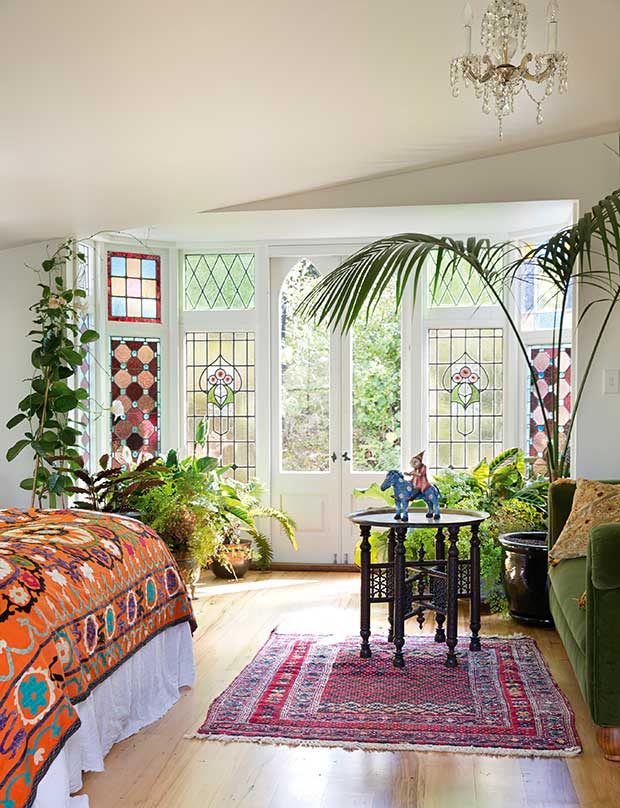
Stained-glass windows and tropical plants (including a quirky pineapple chandelier) are a feature of Suzie’s guest room, office and bathroom.
The mayor snapped shut her proposal with such vigour, an eruption of silver flecks flew across the room. “Well girlie, the best advice I can give you is to leave town – you need to go to a bigger city,” he said looking at the glitter scattered across the mayoral carpet.
“I didn’t let it get to me; I never had any doubt the event would succeed. I could see the show as it is today – on the scale and as spectacular as it is now in its 30th year.”
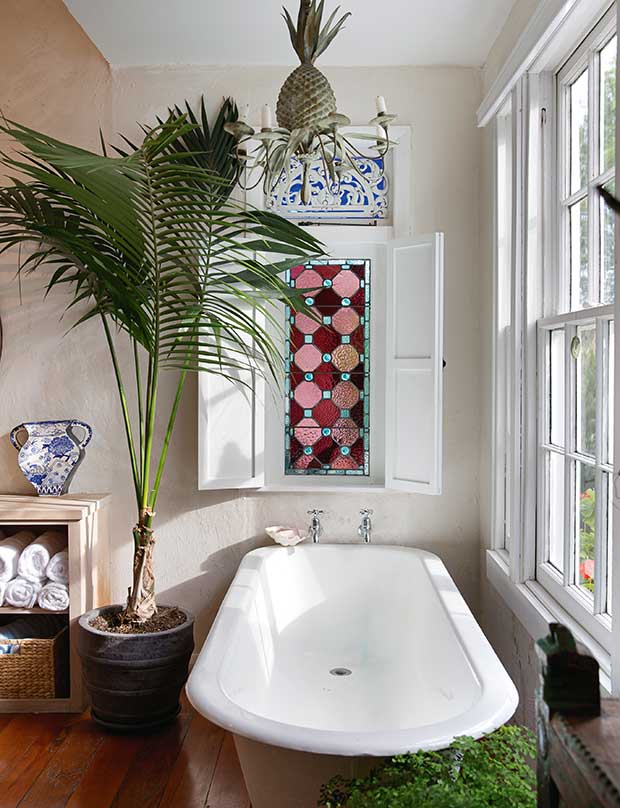
The colourful and tropical theme continues into the main bathroom.
Then there was the man at the DPB office who, unbeknown to him, almost gutted the festival by signing up Suzie to a job in fish processing. “Wearable art? I don’t see much call for that; I’ll put you down for fish filleting.” Instead, Suzie returned to work on the show.
“Thankfully, they were a little looser about job placement then.”
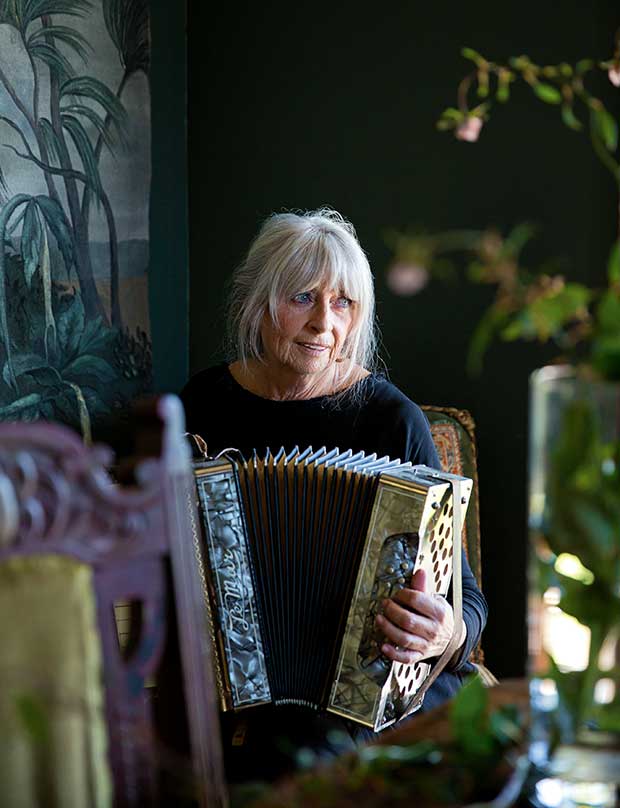
Suzie plays several instruments, including the piano and ukulele. She learnt the accordion from her father.
Asked if she had any government help to start up WOW, she gives a wry smile. “I say, ‘Yes, in the early days the government did help – I was on the DPB, and I’m very grateful.’”
Every room in Suzie’s house is filled with works of art, many of which are props from former WOW shows – a taxidermal bear here, a Hieronymus Bosch-inspired Cupid there.
There are pieces from artists who have appeared in the show such as Sally Burton who was involved in the first year and a striking piece from Kerrie Hughes who was a judge last year.
- The 1991 Supreme WOW award winner for her garment ‘Pallas Athene’.
- The deer sculpture on the gate is from Suzie and Emma’s favourite antique shop, Richmond Antiques & Curios
- The gravity-defying human pyramid is part of a circus series Suzie sculpted in 1985
- The taxidermy rabbit may appear in this year’s WOW show
Hard as it is to imagine, in this art-filled house alongside the creative spirit of WOW, art was absent in Suzie’s life from her late teens to her early 30s.
At school, she was in the country’s top three for School Certificate art so she was allowed to skip her University Entrance year and enrolled for the prestigious Fine Arts Preliminary exam. “My marks came back, and I’d passed in English and failed in art. My world crashed around me as all I had wanted to do, since I was a very tiny child, was to be an artist.”
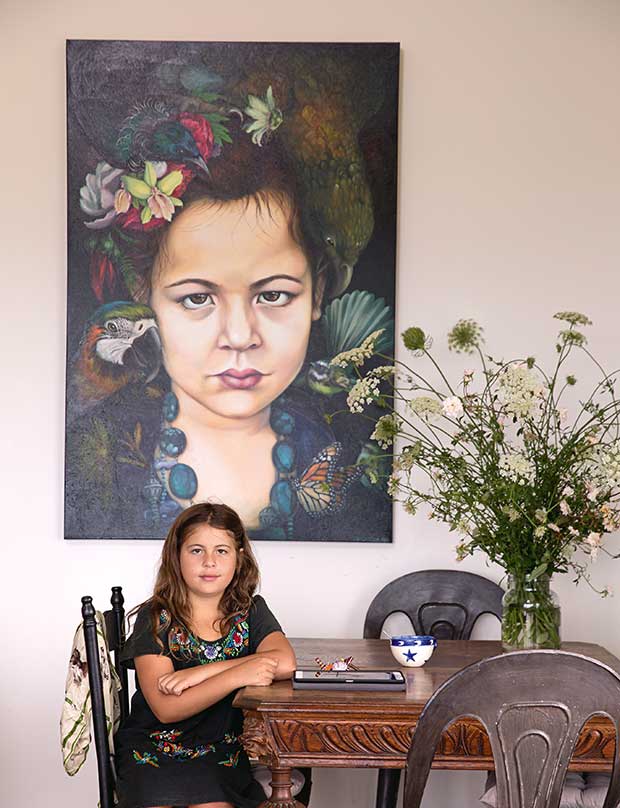
A portrait of Daisy with flowers in her hair (in the style of Frida Kahlo) is by Christchurch artist Nina Cook.
A second letdown came at teachers’ college after artist Quentin MacFarlane encouraged her to enroll at art school. She failed again on the administrative technicality that she had not completed University Entrance and was not old enough to gain entrance on age alone.
“That really set me on a bit of an emotional tangent. I packed away all my painting brushes and anything to do with art into a box.”
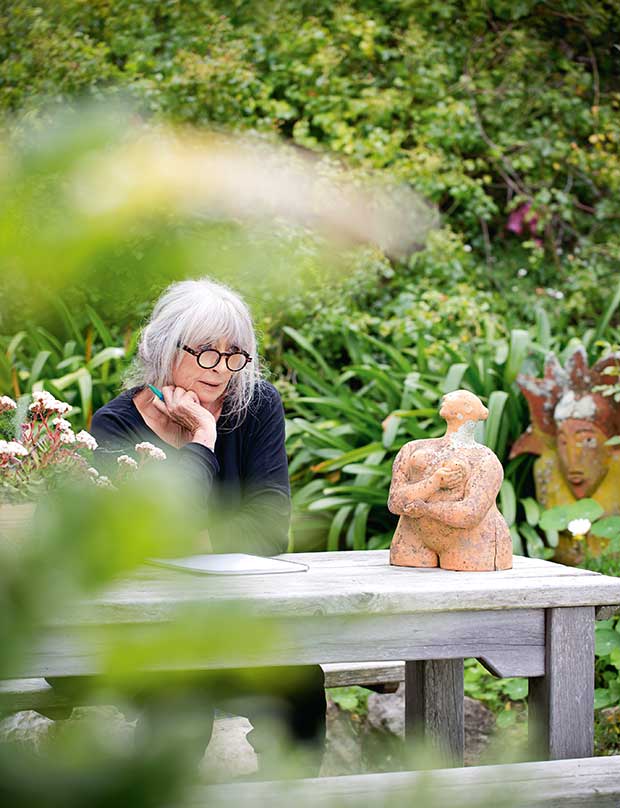
When the weather is fine, Suzie scripts her WOW show on the outside table which is home to one of her sculptures.
Part of her running-away period was spent in Western Australia raising Emma. It was here she met a Catholic priest who came from China and was an artist. “His landscapes were beautiful and it was through my friendship with him that my confidence in myself as an artist was rekindled.”
She began sculpting again.
“I’m really grateful for that early disappointment because if I had gone to art school, I would probably have had a lovely quiet life and WOW would never have happened.”
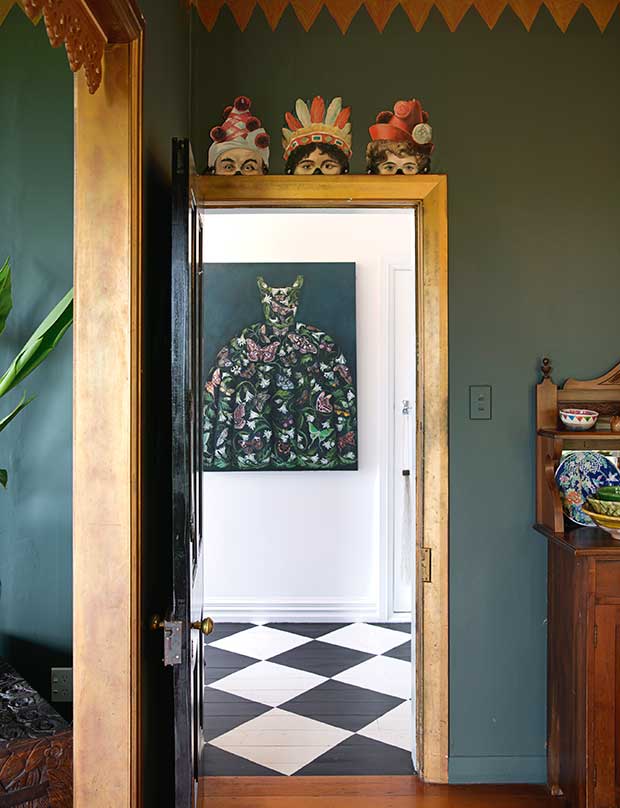
Through the hallway is one of the dresses in a series by Emma – the fabric of the gown is painted with intricate butterflies.
This year Suzie is back scripting the show after a few years off, working with artistic director Malia Johnston and the rest of the creative team.
Malia worked on WOW from 2001 to 2014 firstly as assistant to the choreographer, then as principal choreographer and finally artistic director.
Suzie is excited that WOW is moving into the global arena with an international touring exhibition, developed in partnership with the government, which has visited five venues so far including the Museum of Pop Culture in Seattle, the Peabody Essex Museum in Salem Massachusetts, and will tour St Petersburg later this year.
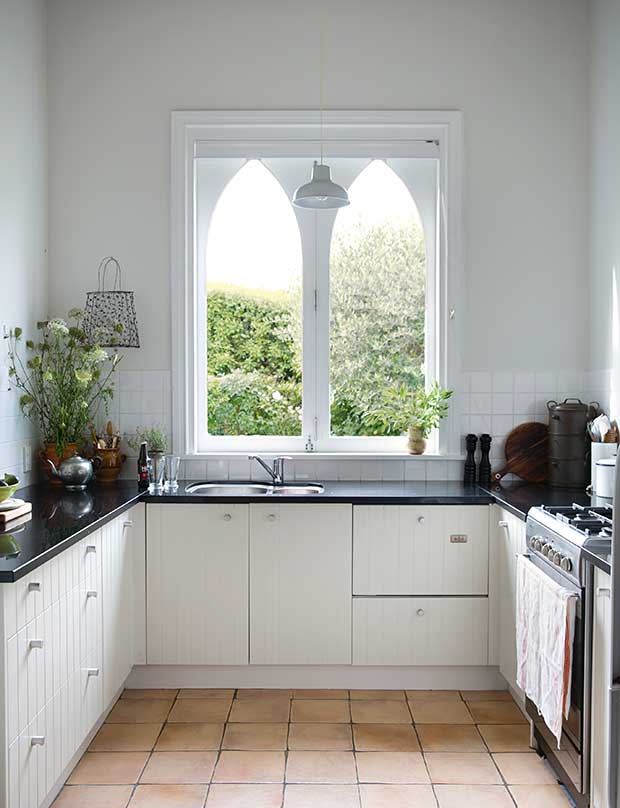
Windows in the kitchen are from an old church.
Suzie says WOW’s future could be as a touring show similar to Cirque du Soleil.
She has always had international aspirations for the show. In the early days Suzie tried to get the show to visit Paris taking the French Embassy by storm with models wearing outrageous costumes in a publicity stunt that made the TV news.
In hindsight Suzie doesn’t believe WOW suffered from not being able to go global earlier: “I didn’t travel until I was older; when I did, I was a bit disappointed. I’d imagined the world so much bigger and more colourful. Maybe that’s why we need WOW – to bring that colour.”
- Although Emma is focused on painting, she’s also a 3D artist and sculpted the unusual blue birds
- A boat from the Hieronymus Bosch-themed 2005 show.
- The circus figure is by artist Helen Black while Emma created the spotted horse
A FAMILY AFFAIR
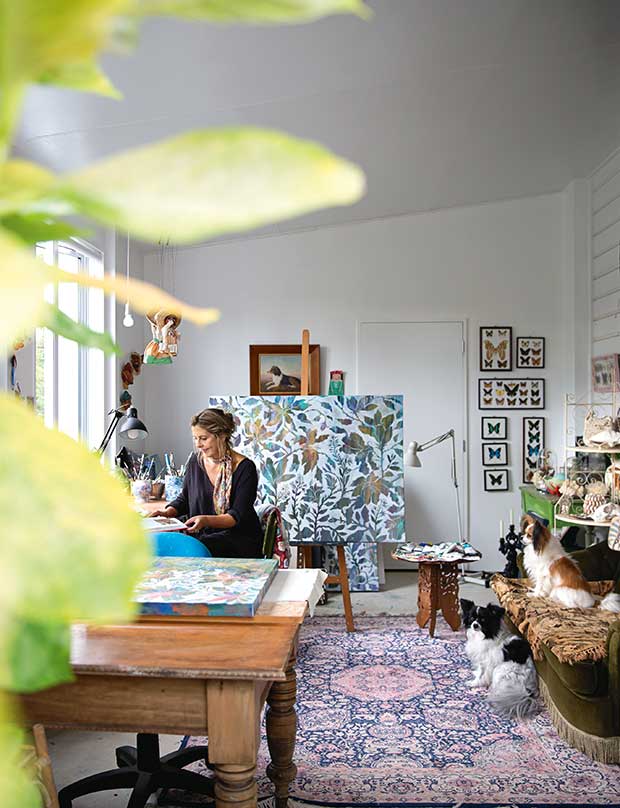
Papillons Sammie and Margaret keep Emma company while she works on a botanical painting. The breed gets its name for its wing-like ears and it’s easy to see why when looking at the framed butterflies which were used as reference for the dress painting in Suzie’s house.
Daughter Emma has worked with Suzie on WOW since the start, modeling garments (albeit reluctantly) as a teenager and later writing the show, as well as in the art department creating props.
These days she’s focused on painting – a series of dresses with intricate illustrations of butterflies and ancient creatures within the dress design.
They are inspired in part by the costumes of WOW and the way the show takes the viewer into another world.
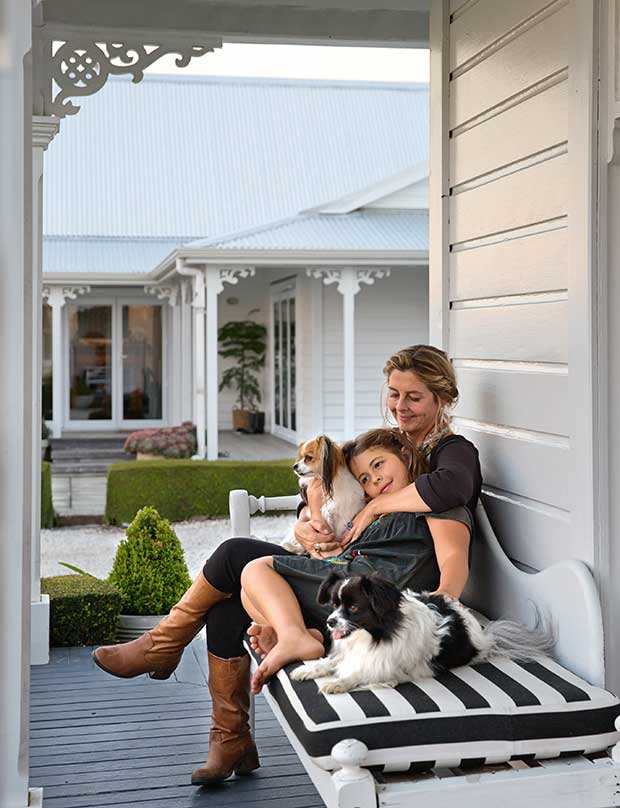
Nine-year-old Daisy inherited an artistic streak and loves to perform. Suzie’s father (Daisy’s great grandfather) was in a band and her mother, who lives in Wakefield, had a comedy act.
This is a close mother-daughter pair: “Growing up with mum, money was tight but I never felt like I did without. It was a creative environment and a home of beauty and wonder,” says Emma, who now lives with her daughter Daisy in the house next door.
“I’m so proud of Emma,” says Suzie. “She’s talented, there’s so much detail in her pieces, and they take many months to complete.”
WOWSERS!
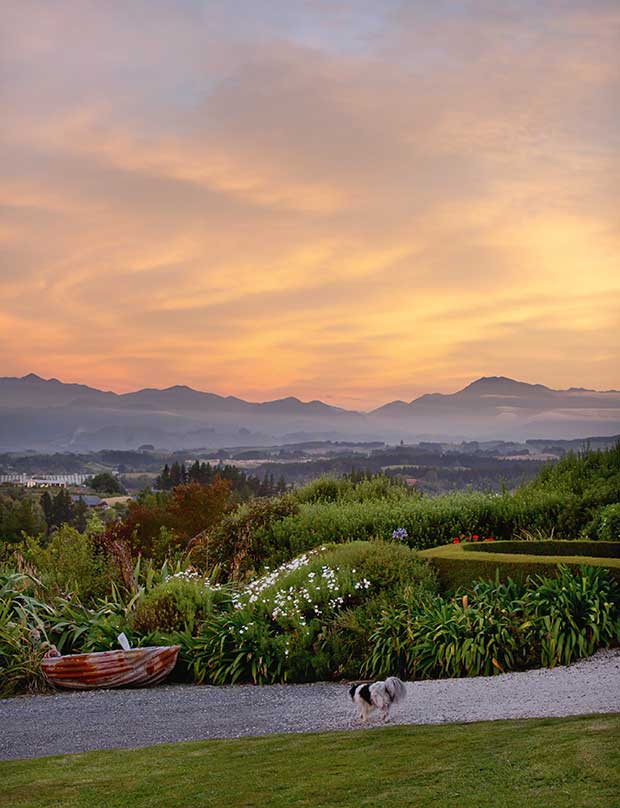
Beautiful light settles over Ruby Bay and Mapua, the haunt of artistic souls for many years. The boat in the garden is by sculptor Jeff Thomson (a previous WOW award winner and judge).
• Suzie says she and the team put their all into the 30th-anniversary show. First-time attendees are often blown away by the scale and spectacle of WOW.
• The show is divided into different “worlds” (categories) with some repeated each year such as ‘Avant-garde’ and ‘Aotearoa’, some every second year (the popular ‘Bizarre Bra’) and one-off themes such as this year’s ‘Under the Microscope’ and ‘Reflective Surfaces’.
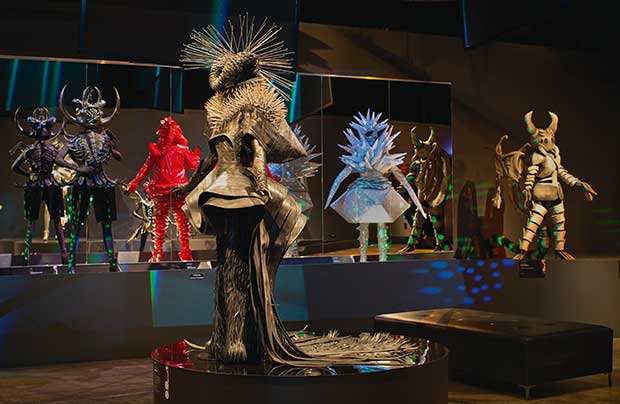
At the National WOW Museum in Nelson, work from the science-fiction section of the 2017 show is displayed along with garments from that year.
• Wearable art is a difficult concept to explain to the uninitiated, says Suzie. For the first show in 1987, she realized that to help people understand the idea of three-dimensional art displayed on the human body, she needed something to show people, so she created a mask from the pelvic bones of two dead cows and artist friend Sally Burton created a piece made from gourds.
• The New Zealand Wearable Art Awards became the World of WearableArt (WOW) in 2000, opened in the National WOW Museum in Nelson in 2001 and then moved to Wellington in 2005, due to size and financial reasons. “The show would have closed if it had stayed in Nelson; it was becoming too expensive to make it here.”
Love this story? Subscribe now!
 This article first appeared in NZ Life & Leisure Magazine.
This article first appeared in NZ Life & Leisure Magazine.
